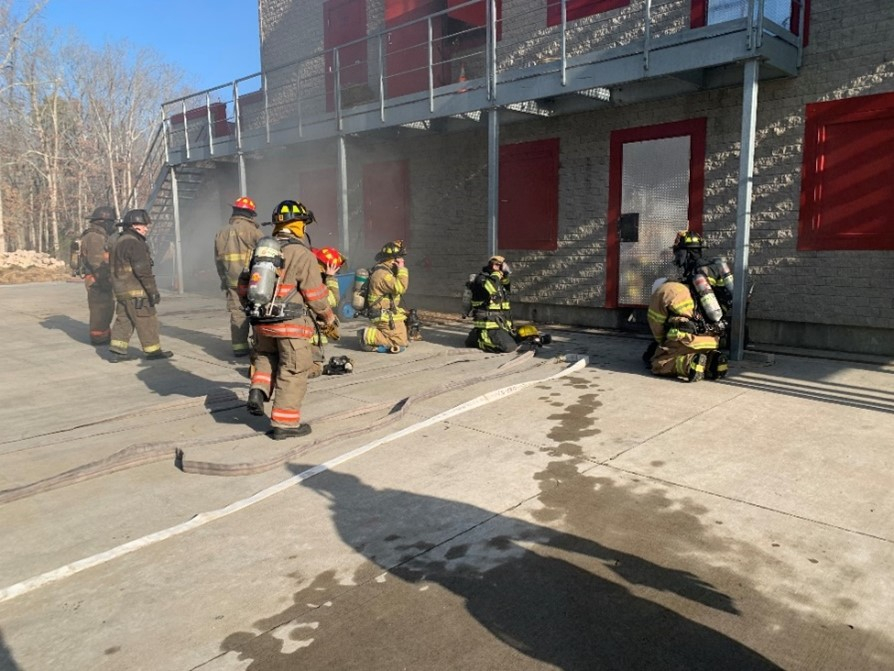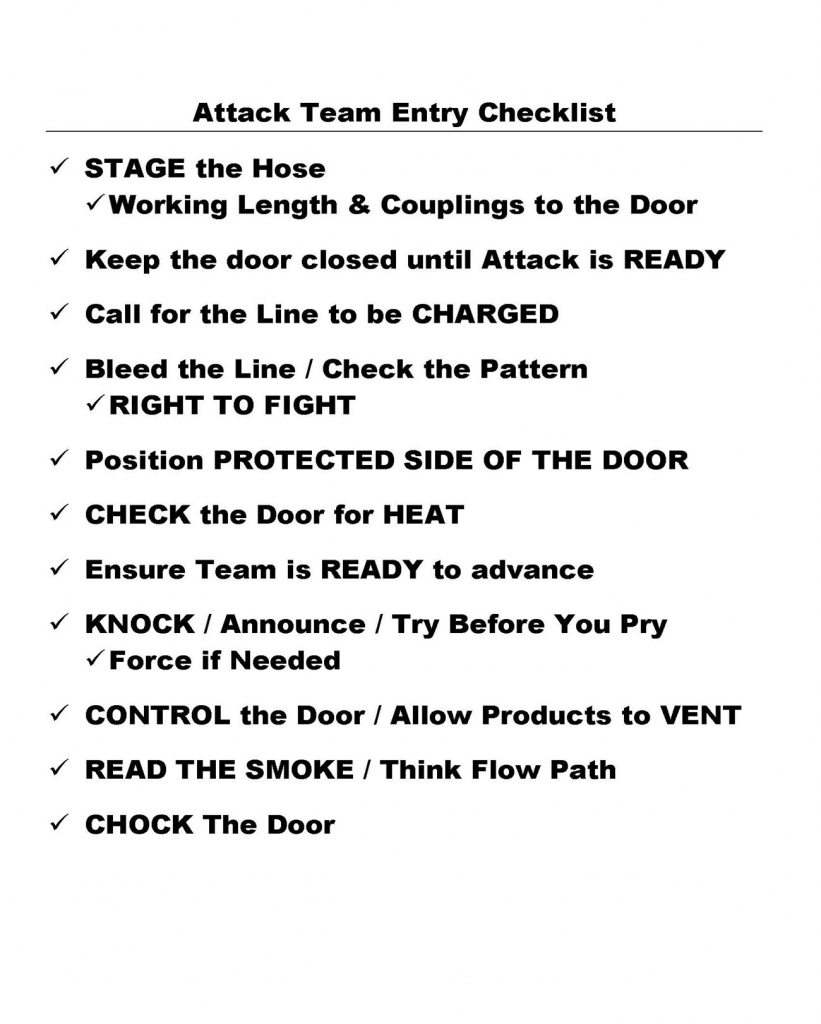Advancing a hoseline into the fire building must be well coordinated and once past the entry door, can look like a work or art or a train wreck. Often, the problems occur before the door is even opened. The attack process must be done right from beginning to water application. More times than not, the things that are missed are Firefighter 1 activities. Some examples are poorly packed hose beds, failure to communicate during the pull, snagged hoselines and piles and piles of spaghetti. These create delays that can be a difference between saving a life or not. Pay attention to the little things so the big things can be taken care of.
When we train our recruits at the Academy on how to prepare for a fire attack, we use a simple checklist that we not only drill into them, but we also have attached to the doors at the entry points to our drill buildings. I will share some of these as failures here usually cause a poor stretch.
- Stage the line with the working length and couplings to the door
The more organized the layout, the easier the stretch. For a lower floor or cellar fire, the working length should be stretched out on the protected side of the door as the team masks up and gets ready to advance. The other lengths should be laid out with the couplings at the door next to each other so once the line is charged and advanced, assisting firefighters can more easily advance the line without snags. For an upper floor fire, once the uncharged working length goes through the door, the rest of the line is bus-wheeled up the stairs to the floor below the fire where the working length and any other hose is flaked out. A good rule of thumb for charging the line is never advance a dry line into any area where a smoke condition exists. S#%t happens when we are not prepared for a fire location surprise. Always be ready. Staging the uncharged line properly for an efficient stretch starts the operation in a positive way.

Picture shows the nozzle, the working length and the next two lengths laid out with the couplings to the door. The team is now masking up for attack.
- Keep the door closed until the attack is ready to go
If Ladder company firefighters enter to check for the location of the fire and any victims, close the door so as not to create unwanted flow path activity. You may not only save the life of a victim; you might also save the life of the Ladder crew.
- Call for the line to be charged
Do not call for the line to be charged until the nozzle firefighter is ready for it. Too many things can go wrong by charging a line that was not called for. The pump operator must confirm and acknowledge this request.
- Bleed the line / Check the pattern – Right to Fight
The Nozzle firefighter should turn away from the team and expel air from the line while at the same time checking the pattern. Failure to so this can result in opening the nozzle with a wide fog pattern in the fire area. This can cause steam burns, alter flow paths, and upset thermal balance. All bad things.
- Position on the Protected Side of the Door
Failure to do this is something I see all the time, not only at the Academy on our drill ground as departments come in to do live burn, but in the field as well. This is attack operation complacency and laziness at its worst. Recognize door swing and be on the side of the door so that when it is opened, it will not spew fire and heat at the team. Surprises are not nice on the fireground. This also goes for apartment hallway doors on the upper floors of a multiple dwelling. In fact, everything in this column, applies to anywhere the attack is being started from. For upper floor attack, some minor adjustments inside the building will be required such as charging the line on the floor below the fire, but everything here is applicable.
Whether outside the doorway on the exterior or on an upper floor, the door must be checked for heat. A solid door can hold back a lot of fire, but the door temperatures, especially the metallic parts like the knob will not lie. Once the door is open and uncontrolled, it is too late. If you are not ready because you did not check, your attack and your crew will be in jeopardy.
- Ensure the team is READY to advance
Attack operations require all members to be ready. This means properly masked up with gloves on, positioned on the proper side of the line and the entry door, and aware of the plan.
- Announce / Try Before You Pry / Force if Needed
Announcing you are about to enter may not always apply but it often does in multiple dwellings when you have a smoke condition and are unsure of where it is coming from. Tenants do not always want to open the door especially if they think they might get in trouble. This is especially true with food on the stove. So, while try before you try should be a mantra of every entry team, being prepared for forcible entry is required as is being prepared for what is on the other side of the door. It could be fire, it could be smoke, it could be a big dog, it could be an irate tenant with a gun. Letting them know you are the Fire Department before you pry, especially in minor incident situations is a safety activity.
- Control the Door / Allow Products to Vent
Failure to control the door as it is opened has caused many firefighter fatalities, especially if companies are working on searching and clearing the upper floors. Be sure that you can control the door and ensure that firefighters as well as occupants are off the stairs and out of the stairwell. Failure to control the door, especially during training evolutions, is something I see way too often and if it is happening on the training ground, you know it is happening in the field.
Once the attack team (or any team) is ready to enter, the door should only be opened a crack. Put your body weight against it so it can be closed quickly if needed or to allow the products of combustion to vent away from the face of the entry team. A face full of fire is never a good thing. A door opening away from the team, such as in an apartment building will require the same door control as when opening an outward-swinging entry door. Rope or chain is useful for this operation. Always prepare for fire that is ready to burst out of the door as it is opened…and don’t be in its way.
- Read the Smoke / Think Flow Path
Look at the smoke issuing from the door. If you are outside, full door smoke can signal a below grade fire. If you have not done it already, check these areas before proceeding and very carefully check the stability of the floor. Firefighters have fallen though the floor as soon as they have entered the building due to a fire burning away the floor supports. Smoke at the top of the door often signals a fire that is above you and smoke midway in the doorway often means the fire is on that floor. These are pretty reliable rules of thumb. The smaller the building dimensions, the more accurate the doorway read will be. Know where your fire is likely to be before you attack. Additionally, remember you are likely to be creating a flow path as you enter. Be prepared for the fire to find you as it seeks this path. Take note of wind conditions as well as this can alter attack (and fire movement) direction.
- Chock the Door as entry is made
This is another one of those activities that is forgotten. An unchocked door will limit water and stall the attack, often trapping the attack team on the wrong side of the problem with no water. The chock duty should be assigned as a matter of SOP. Usually the second firefighter on the line or the Officer (who should be near the front of the line) should chock the door. Oh, and BTW, the Officer should NOT be on the nozzle. You cannot supervise and check conditions while on the nozzle. If you want to squirt water, refuse the promotion!

This column was all about attack team readiness. It is the responsibility of the Company Officer to ensure readiness. Is this being taken care of in your Department?
Below is a ready-to-print attack team checklist.
